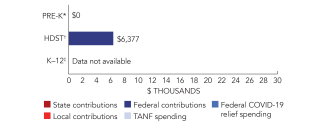
State of Preschool
American Samoa
No Program
American Samoa does not provide publicly funded preschool as defined in this report but does support early childhood education in several other ways. The Early Childhood Education/Head Start (ECE/HS) division is housed within the American Samoa Department of Education (ASDOE). The ASDOE and both elementary and secondary schools operate early childhood education centers.
American Samoa’s early learning guidelines, for children ages three to five, address multiple domains including social and emotional development, mathematics, science, approaches to learning, logic and reasoning, social studies, physical development and health, language development, literacy, English language development, and creative arts expression. The early learning guidelines are aligned with the Head Start Child Development and Learning Framework.
As of January 2017, American Samoa was in the late stages of developing a quality rating and improvement system (QRIS) with components including parent engagement, administration, professional development, and health/safety. However, given limited resources, the Child Care Division will begin with a Territory system for quality monitoring and develop a rating platform that better aligns with the unique island early learning and care environments in American Samoa.
American Samoa
Access
| Total state pre-K enrollment | 0 |
| School districts that offer state program | NA |
| Income requirement | NA |
| Minimum hours of operation | NA |
| Operating schedule | NA |
| Special education enrollment, ages 3 and 4 | 31 |
| Federally funded Head Start enrollment, ages 3 and 4 | 840 |
| State-funded Head Start enrollment, ages 3 and 4 | Not reported |
Resources
| Total state pre-K spending | $0 |
| Local match required? | NA |
| State Head Start spending | Not reported |
| State spending per child enrolled | $0 |
| All reported spending per child enrolled* | $0 |

*Pre-K programs may receive additional funds from federal or local sources that are not included in this figure. †Head Start per-child spending includes funding only for 3- and 4-year-olds. ‡K–12 expenditures include capital spending as well as current operating expenditures.